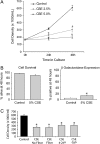Cigarette smoke induces cellular senescence
- PMID: 16840774
- PMCID: PMC2643295
- DOI: 10.1165/rcmb.2006-0169OC
Cigarette smoke induces cellular senescence
Abstract
Chronic obstructive pulmonary disease (COPD) is the fourth leading cause of death in the United States, and cigarette smoking is the major risk factor for COPD. Fibroblasts play an important role in repair and lung homeostasis. Recent studies have demonstrated a reduced growth rate for lung fibroblasts in patients with COPD. In this study we examined the effect of cigarette smoke extract (CSE) on fibroblast proliferative capacity. We found that cigarette smoke stopped proliferation of lung fibroblasts and upregulated two pathways linked to cell senescence (a biological process associated with cell longevity and an inability to replicate), p53 and p16-retinoblastoma protein pathways. We compared a single exposure of CSE to multiple exposures over an extended time course. A single exposure to CSE led to cell growth inhibition at multiple phases of the cell cycle without killing the cells. The decrease in proliferation was accompanied by increased ATM, p53, and p21 activity. However, several important senescent markers were not present in the cells at an earlier time point. When we examined multiple exposures to CSE, we found that the cells had profound growth arrest, a flat and enlarged morphology, upregulated p16, and senescence-associated beta-galactosidase activity, which is consistent with a classic senescent phenotype. These observations suggest that while a single exposure to cigarette smoke inhibits normal fibroblast proliferation (required for lung repair), multiple exposures to cigarette smoke move cells into an irreversible state of senescence. This inability to repair lung injury may be an essential feature of emphysema.
Figures






References
-
- Pauwels RA, Buist AS, Calverley PM, Jenkins CR, Hurd SS. Global strategy for the diagnosis, management, and prevention of chronic obstructive pulmonary disease. NHLBI/WHO Global Initiative for Chronic Obstructive Lung Disease (GOLD) Workshop summary. Am J Respir Crit Care Med 2001;163:1256–1276. - PubMed
-
- Murphy SL. Deaths: final data for 1998. Natl Vital Stat Rep 2000;48:1–105. - PubMed
-
- Mannino DM, Homa DM, Akinbami LJ, Ford ES, Redd SC. Chronic obstructive pulmonary disease surveillance--United States, 1971–2000. MMWR Surveill Summ 2002;51:1–16. - PubMed
-
- Fishman AP. One hundred years of COPD. Am J Respir Crit Care Med 2005;171:941–948. - PubMed
-
- Absher M. Fibroblasts. In: Massaro D, editor. Lung biology in health and disease. New York: Marcel Dekker Inc.; 1995. pp. 401–439.
Publication types
MeSH terms
Substances
Grants and funding
LinkOut - more resources
Full Text Sources
Research Materials
Miscellaneous

